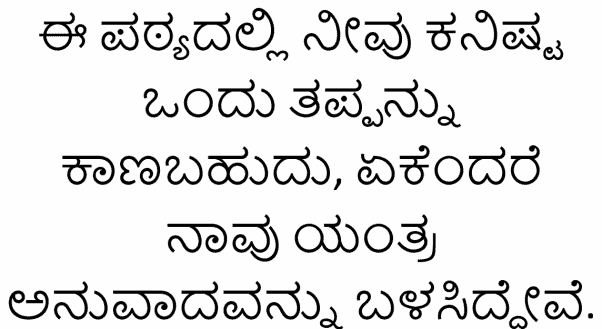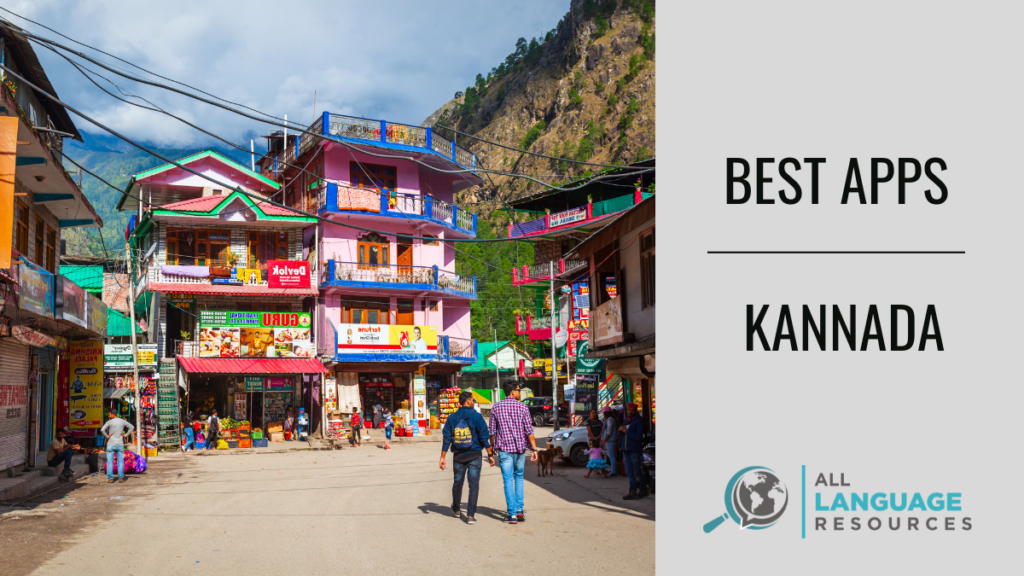Interested in learning Kannada? You’ll be surprised by the variety of Kannada resources available online.
Starting to learn a language can be overwhelming, especially with the numerous resources online, it’s hard to choose which one to use. Fortunately, we’ve meticulously tested various resource options to bring you our top picks, making it easier for you to focus on learning rather than searching.
We’ve curated a list of the best apps, courses, classes, YouTube, podcasts, and other media as well as which ones to avoid for learning Kannada language just for you. Hopefully, our insights can help you discover what fits your learning style and goal best.
Table of Contents
Where to Learn Kannada: Resources for Learning Kannada
Courses, classes, apps, podcasts, movies, textbooks, fiction books: you might be surprised to discover just how many options there are for studying Kannada.
Learning the Kannada Script
Even if your main goal is to speak Kannada, you’ll need to learn the script in order to decipher bus timetables, read menus and prices, and understand street signs. Fortunately, it shouldn’t take you too long.
The Kannada Alphabet app will help you read and pronounce the Kannada script. In each mini-lesson, you’re introduced to four or five different characters and asked to select the right sound. We found it surprisingly effective at helping you recognize different characters, but it won’t teach you to write.
You could try combining it with the Kannada101 app, in which you trace the characters on your screen to receive a score out of 100.
Sometimes it can help to watch someone else draw the characters. Give this YouTube video from Sugama Kannada a go. When you’re ready to learn how to connect vowels and consonants, move on to parts 2, 3, and 4.
Alternatively, for something that goes a bit slower and more in-depth, watch this YouTube playlist from Kannada TV.

Online Kannada Classes and Language Exchanges
No matter how much grammar or vocabulary you learn, you won’t improve your spoken fluency until you actually start speaking the language. Here are a few options.
Kannada Classes
A teacher can guide you through grammar rules, give you personalized feedback, and help make sure you’re speaking as well as studying Kannada.
Before you go hunting the web for online teachers, it’s worth asking at your nearest temple. Some of them offer free or affordable classes, and you’ll also benefit from getting to know other Kannada learners.
No luck at your local temple? Hindustani Tongue is an answer to our collective Kannada students’ prayers. It is a 1-on-1 tutoring course with native Kannada speaking teachers, and compared to other tutoring platforms, its teachers go through robust training sessions and there is a framework of basic language learning progressions. This takes much of the guesswork out of picking teachers that plagues other tutoring platforms. Another great thing about Hindustani Tongue is that your previous lessons are all available in Google Classroom for you to review for as long as you are a student! And you can ask questions to your teacher via chat any time.
italki is one of the oldest online language-learning marketplaces. You can take private one-to-one video classes with a tutor of your choice – although, unfortunately, italki only has a handful of Kannada teachers at this moment in time.
While it doesn’t have a lot of choice, we think italki is a good option for most students, especially because of its free community features. If you download the app, you can take part in the forums and get community feedback on your writing and speaking.
Looking for more options? TeacherOn.com, which started off as TutorIndia, has hundreds of Kannada teachers for you to choose from. You can only contact the first three for free, however: after that, you have to pay. Alternatively, you can post that you’re looking for Kannada tutors and wait for them to contact you – that’s free.
Just Learn also has a couple of Kannada tutors for you to choose from. With this platform, you have to sign up for a subscription for either 4, 8, or 16 classes per month.
IndLangs promises to get you comfortable speaking Kannada after just ten 90-minute Skype lessons. They also have a reading and writing course.

Community Feedback
Sometimes, you just need a fellow learner or native speaker to offer a helping hand. Perhaps you’ve come across an idiom that isn’t in the dictionary, or you’d like someone to tell you if a sentence you’ve written is grammatically correct.
While online classes can be a great space for this, community feedback can also give you a quick answer. Just remember to give as much support to the community as you receive. Stick around and answer a few questions, if you can.
Download the HiNative app to ask and answer questions on the go. Unfortunately, there aren’t many posts about Kannada (and community members sometimes mistake it for Canada), but we think it’s still worth trying. After all, you never know if a Kannadiga is lurking.
Alternatively, try the WordReference forums or even the Kannada sub on Reddit.
You can use the newly launched LangCorrect to share your journal entries, get feedback, and help out a fellow learner. In our experience, it’s a great resource for improving your writing, but you might struggle to get enough feedback unless you’re learning a common language. Still, if you’re writing something in Kannada anyway, there’s no harm in posting it there as well.

Kannada Language Exchanges
There’s nothing like speaking Kannada with native speakers to improve your fluency, response time, and confidence. Fortunately, you don’t have to go to Karnataka to do this.
There are several language exchange apps, such as Speaky, HelloTalk, and Tandem, that will help you meet Kannada speakers and have conversations. Some of them have extra features, such as one-touch translations and corrections. There are a few differences between the apps, so it’s worth checking out our reviews (Speaky, HelloTalk, Tandem) or our HelloTalk and Tandem comparison to help you choose between them.
Interested in an in-person language exchange? Try MeetUp. While it only has a few Kannada-specific groups, there are plenty of language exchanges where you might meet a Kannada speaker. Alternatively, you can create your own group or try Facebook groups.
Although you can make great friends at language exchanges, be cautious at first. Remember that everyone’s a stranger. Meet up in public and don’t be afraid to set boundaries or refuse to give out your contact details. After all, you can always see them at the next MeetUp.

Kannada Language Courses: Online, App-Based, & Audio
Signing up for an online or app-based course will give your learning structure and make it easier to measure your progress. You might find it keeps you motivated. And while you won’t see Kannada courses on Rosetta Stone, Duolingo, Busuu, or Babbel, we’ve found plenty of alternatives that are worth trying out.
Ling Kannada
If you like the visual appeal and gamified structure of Duolingo, you will gel with Ling’s fun app. Just like in Duolingo, you get tons of micro rewards for completing short daily lessons and activities.
People who like a more visual learning style will appreciate the cute cartoon characters and vivid colors of the design. Audio learners will like that all the sample dialogues feature native speakers, which will help with listening comprehension skills.
From a practical perspective, Ling does a good job of featuring all the essential components of a language in its lessons. You get exposure to listening, reading, writing, and speaking activities in the app.
That said, the app will not carry you beyond the basics. It does include some grammar explanations, but not enough to give you a solid understanding of the language. It offers a fun place to start or a quick brush-up for someone getting ready to travel.
Simply Learn Kannada
Simply Learn Kannada is another app from Simya Solutions, the same company that launched Ling. Simply Learn Kannada is a promising flashcard app but it does not include the depth of lessons and resources you would find in Ling.
It could serve as a fun auxiliary tool, but we would choose Ling over it. After all, you’ll also practice your speaking with Ling and pick up some basic grammar.
Kannada Kalike
Kannada Kalike presents a series of video lessons for a beginner. The lessons take you from learning the alphabet to cases, conditionals, and written and spoken differences. For people who already know the alphabet, there are also more challenging videos.
The 30 modules focus on grammar and can get dull, but they provide a clear and thorough introduction to Kannada. We recommend pairing the online videos with flashcards, as well as studying extra vocabulary.
KannadaGottilla
When you’re ready to move on from Kannada Kalike, you could take a look at KannadaGottilla and their gender- and level-segregated WhatsApp groups. You’ll receive daily tutelage, submit homework, and be able to ask your mentor any questions. Plus, it gives you instant access to a Kannada-learning community of 25–30 people.
This newer learning program promises to teach you conversational Kannada in just 30 days. It is gaining popularity and has worked with over 22,000 students in 11 different countries to date.
Learn Kannada SmartAPP
The freemium app Learn Kannada will teach you basic Kannada through short video lessons. It uses gamification and spaced repetition to help you remember the material for longer. You can also sign up for online classes and take a ten-day basics course to get you started.
One of the cool things about this app is that you can learn it differently depending on your native language. You can also see a leaderboard to compare your progress to other users globally.
The Words and Conversations section lets you practice for practical life scenarios, like talking with a doctor.
Bluebird
Alternatively, Bluebird is a Pimsleur-esque freemium app with a heavy focus on listening and speaking. While we think it can be disorganized, it will get you used to listening to native speakers.
You may need to slow down the dialogues in order to hear pronunciation and repeat it as you build your listening comprehension skills. But you will progress through a series of useful grammar and conversation lessons, all for free!

Memrise
Memrise doesn’t have an official Kannada review, but it does boast a handful of community-made ones. We think Memrise is a fun and effective app, but bear in mind that the course quality will vary. Try a few courses for free to find the right one for you.
Udemy
Udemy currently offers three Kannada courses. Since Udemy is just a marketplace, the quality and depth of the courses will vary. Take a good look at the syllabus and reviews before purchasing and remember that Udemy (at the time of publishing this article) offers 30-day refunds.
Anki
No matter your Kannada level, Anki is a great tool. You can create your own flashcard sets or use someone else’s. The app adapts to how difficult you find certain words, and you can also add images and audio files to the flash cards.
This tool does require a little more work from you, but it will help you remember your pool of core vocabulary words super quickly!
Brainscape
You might also like Brainscape. It’s similar to Anki but has a more modern and polished appearance. Instead of downloading design tools, you can create your flashcards through the website.
Alternatively, you could try using apps and websites that will introduce you to new vocabulary, as well as help you drill them.
UTalk
uTalk will get you memorizing phrases for everything from colors, professions, and ordering food to natural disasters and maintaining military peace. We like that you can record yourself speaking in Kannada.

Kannada Baruthe
Kannada Baruthe is a widely recommended word and phrase list app covering everything from family members to going shopping. We think the word lists are valuable, but there’s no way to drill the new vocabulary. You’ll need to pair it with a flashcard app like Anki instead.
You could use the word lists kind of as a checklist to keep track of your vocabulary progress, but this tool will not necessarily help you learn.
50Languages Phrasebook
50Languages has a large number of Kannada word lists, although we felt you’d get the most value out of it if you were to then put it into a flashcard app. The really useful thing about this online phrasebook is that you can pull up a list of words you need in special circumstances like a car breakdown!
Beginner Kannada
Unlike Kannada Baruthe and 50Languages, Beginner Kannada has some basic options for drilling new vocabulary. It also uses spaced repetition, something that’s normally quite helpful for memorizing words. However, we weren’t entirely convinced by its effectiveness and felt it was at times unintuitive.
Language Courses to Avoid
A bad course won’t just waste your time and money: it will also leave you demotivated, frustrated, and speaking potentially incorrect Kannada. So, even though there aren’t many Kannada courses to choose from, we’d stay away from these ones.
Although you’ll find some useful grammar explanations and scanned PDFs hosted by the University of Pennsylvania, we would approach the section labeled preliminary lessons with caution. It’s devoid of explanations and the Kannada script hasn’t rendered correctly. While it’s free and you can pick up some information from it, we believe there are much better options out there.
Vidyamruth has a Spoken Kannada course and a reading and writing video course. The videos introduce some basic vocabulary before either showing how they are used in a dialogue or using them to describe a video. The syllabus looks good, but we weren’t overly impressed by the sample class. We think you could find yourself overwhelmed, especially since there don’t seem to be any practice opportunities.
Instant Immersion bills itself as a Rosetta Stone alternative. However, we felt it was less structured, and it didn’t seem as effective.
As for Cudoo, it has the dubious honor of receiving the joint-worst ranking on our site. We believe you would learn more simply by creating flashcards out of word lists.
You might also come across word lists on iLanguages and MyLanguages. Neither of these left us overly impressed, and MyLanguages has a track history of incorrect information. We would steer clear of these sites.

Learning Kannada Via YouTube
If you feel like you’re too focused on textbook Kannada, or are simply more of an aural learner, YouTube can be a great option.
Kannada TV is a must-subscribe channel. It has playlists on learning Kannada through English and Hindi, as well as ones dedicated to homonyms, vocabulary, dialogues, common phrases, and more.
Agurchand Babu Subramanian has a Learn Kannada playlist that gets progressively more difficult. It does a good job of explaining when to use certain phrases and how to stay polite.
Learn Kannada Online has videos on specific situations, such as visiting the doctor or going to the bank. It can be a great way to brush up beforehand on the phrases you might hear. Plus, there are lots of vocabulary-based videos on everything from flowers to emotions.
Anish Tutorials has playlists on learning Kannada through Tamil and English. We found the English ones unstructured, although they could be useful if you already have a Kannada base and are just looking to pick up an extra word or two. Plus, they’re only a couple of minutes long.

Kannada-Language Podcasts
Looking for ways to improve your listening, pick up new vocabulary, or just fill your commute time? Podcasts are a great way to not only practice Kananda but also listen to something you find interesting.
Every week, The Thalé-Haraté Kannada Podcast takes a deep dive into topics ranging from current affairs to childhood games, and from the natural world to science fiction.
Only have a few minutes to spare? Try Nallikayi, the community-led podcast in which contributors read stories and articles out loud, or listen to children’s bedtime stories with Baalgatha Kannada.
Saacho Sarri is a Christian podcast dedicated to understanding the Bible. It’s updated five days a week and most episodes are around 30 minutes long.
The sporadically updated Hong Maradadi Podcast touches on art, culture, and science.
Cricket fanatic? Cricket Kannadiga is an obvious choice for you.
If these are too challenging, start off with Nithya Kannada instead. Each short-and-sweet episode features a few phrases said in both Kannada and English.


